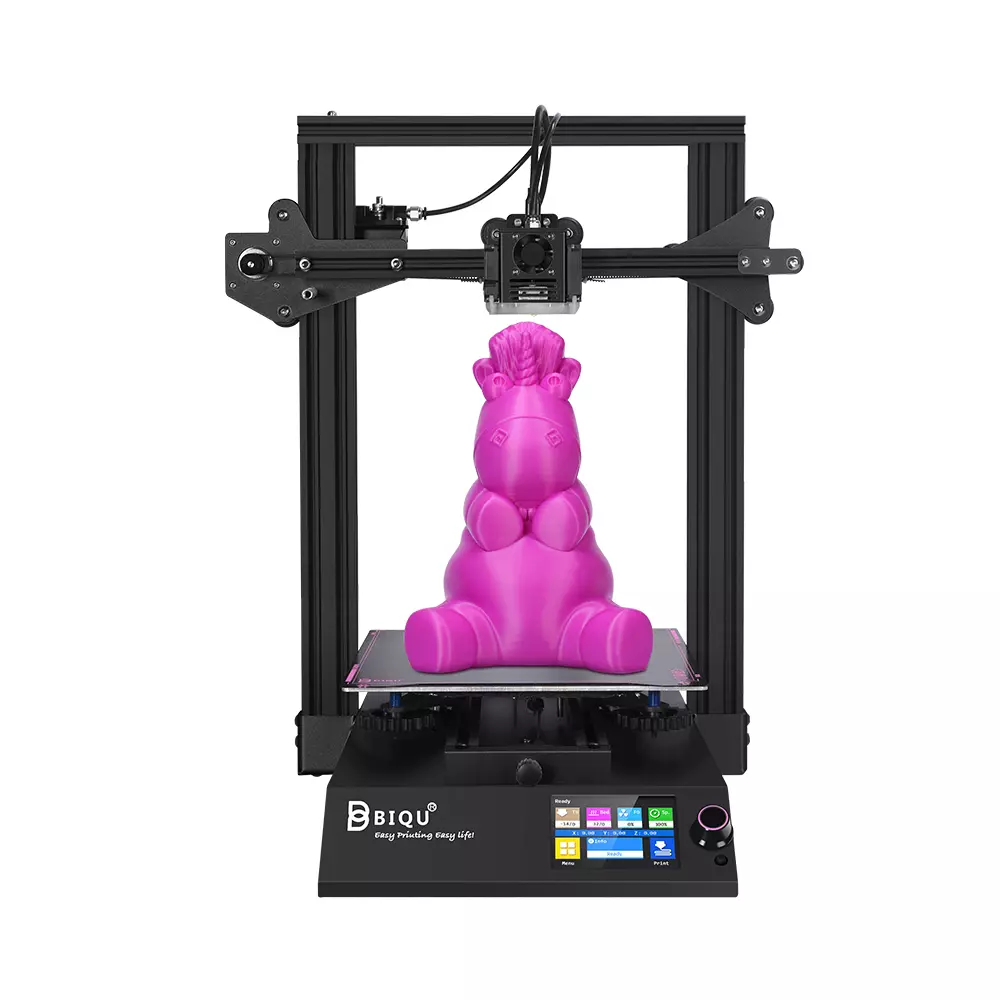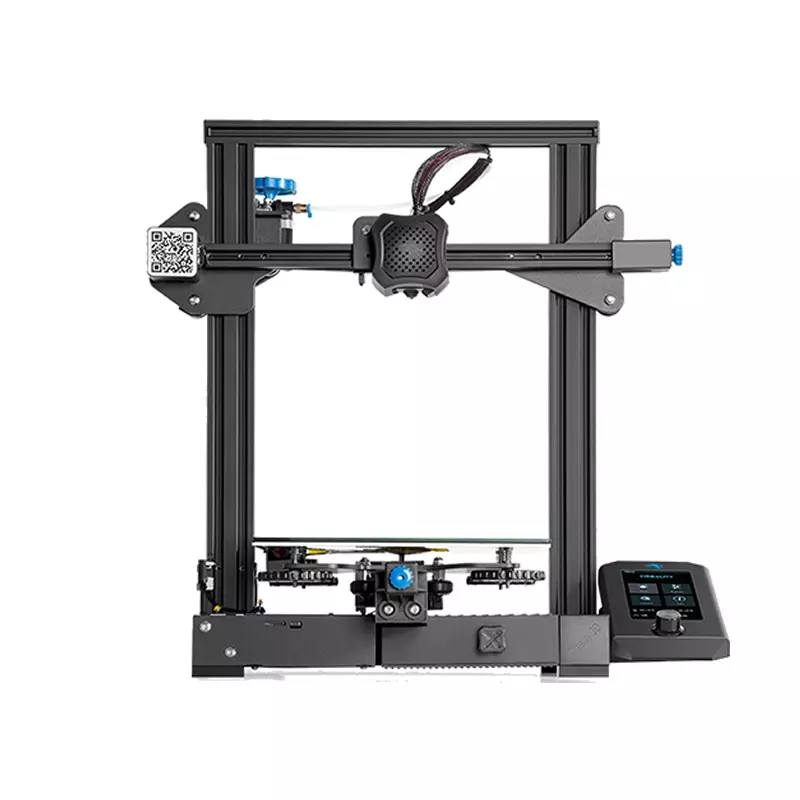Compare Ender 3 vs BIQU B1 vs Ender 3 V2
Comparison between the best 3D printers
Choose the best 3D printer at the best price. The cheapest 3D printers are here.
Buy a 3D printer here with 3D Fila.
 |
 |
 |
|
| Model | Ender 3[BUY Ender 3] |
BIQU B1 |
Ender 3 V2[BUY Ender 3 V2] |
| Printing Material | Filament | Filament | Filament |
| Estimated price | $210,00 | $269,00 | $289,00 |
| Fabricante | Creality 3D | BigTreeTech | Creality 3D |
| Release Year | 2018 | 2020 | 2022 |
| Print Volume [mm] | 220x220x250 | 235x235x270 | 220x220x250 |
| Printer Size [mm] | 440x440x465 | 412x402x492 | 470x475x620 |
| Weight [kg] | 6,62 | 8,00 | 7,8 |
| Power Loss Recovery | NO | YES | YES |
| Enclosed printer | NO | NO | NO |
| Bed Leveling | Manual | Manual | Manual |
| Filament End Sensor | NO | YES | NO |
| Bed type | Heated | Heated | Heated |
| Power supply system | Bowden | Bowden | Bowden |
| Standard nozzle | 0,4 | 0,4 | 0,4 |
| Maximum Nozzle Temperature [°C] | 255 | 250 | 255 |
| Maximum Bed Temperature [°C] | 110 | 100 | 100 |
| Maximum printing speed [mm/s] | 180 | 100 | 180 |
| Filament holder | YES | YES | YES |
| Camera for supervision | NO | NO | NO |
| Recommended filaments | PLA, TPU, ABS, PETG | PLA, TPU, ABS, PETG | PLA, TPU, ABS, PETG |
| Recommended slicers | Cura, Simplify, Slic3r | Cura, Simplify, Slic3r | Cura, Simplify, Slic3r |
| Maximum Resolution [mm] | 0,1 | 0,1 | 0,1 |
| Processor | 8 bits | 32 Bits BTT SKR V 1.4 | 32 bits |
| Display | Mono | Touchscreen TFT 3,5'' | Touchscreen TFT 4,3'' |
| Power Supply | 24V / 270W | 24V / 360W | 24V / 360W |
| Connectivity | SD / USB | SD / USB | SD / USB |
| Operating systems | Windows, Mac, Linux | Windows, Mac, Linux | Windows, Mac, Linux |
| Date of registration in the system | 2021-04-13 | 2021-04-14 | 2021-04-15 |
| Release date | 2018 | 2020 | 2022 |
| Extra features | The Ender 3 V1 is a DIY assembly 3D printer, a sales leader since 2017, standing out for its cost-benefit. With a wide printing capacity, it has a CNC machined structure for precision and stability. It offers high-precision prints with low noise, thanks to its innovative V-profile and pulleys. It has a self-adhesive magnetic platform for easy removal of models and excellent adhesion. The Ender 3 heats up quickly, reaching 100°C in 5 minutes, ideal for agile prints. It includes protection against power failures, allowing you to resume printing after interruptions, saving time and material. | The BIQU B1 is an advanced 3D printer with a silent 32-bit BTT SKR V1.4 motherboard and ARM Cortex-M3 CPU, offering DIY interfaces (I2C, SPI, WiFi) and dual Z-axis. Its dual BTT B1 TFT35 V3.0 operating system allows real-time monitoring and multiple printing modes, including G-code visualization effects. It stands out for its BIQU SSS (Super Spring Steel), ensuring easy model adhesion and simplified removal, with the possibility of using it on both sides. It includes a filament sensor, automatically pausing printing in case of filament breakage. The multicolored RGB lights integrated into the hotend allow you to view the printing status even at night. Additional notes include the need for a BIQU-specific Type-C cable and extra interfaces for smart filament sensor and BL Touch. | The Creality Ender-3 V2, with a design inspired by the Prusa i3 series, stands out for its DIY assembly structure. With an area of ??250x250x250mm, it supports a variety of projects. It has a micro-USB port, microSD slot and integrated tool drawer. The tension adjustment adapts to different regions. Its manual print bed leveling process requires attention, but offers an enriching experience. Ideal for 3D printing enthusiasts willing to invest time in assembly and adjustment. |
| Support for multiple colors and materials (AMS and CFS) | NO | NO | NO |
Notes * |
|||
| Cost-benefit | 6 / 10 | 7 / 10 | 7 / 10 |
| Hardware | 0.5 / 10 | 2 / 10 | 2.1 / 10 |
| Screen | . | . | . |
| Print volume | 3 / 10 | 3 / 10 | 3 / 10 |
| Performance | 1 / 10 | 1 / 10 | 1 / 10 |
| [BUY Ender 3] | [BUY Ender 3 V2] |
Conclusion |
| In comparing the three 3D printers—Ender 3, BIQU B1, and Ender 3 V2—each offers distinct advantages and drawbacks based on their features and pricing. The **Ender 3** is known for its exceptional cost-benefit ratio, making it a popular choice among budget-conscious users. While it offers a solid basic performance with manual bed leveling and a straightforward assembly process, it lacks advanced features such as power loss recovery and filament detection. The **BIQU B1**, while slightly more expensive, provides a range of innovative features, including a silent motherboard and a dual Z-axis for enhanced stability. Its filament sensor is particularly useful, as it pauses printing if filament runs out. This model suggests a higher degree of complexity and customization, appealing to users looking for a more advanced setup and those comfortable with DIY projects. The **Ender 3 V2**, on the other hand, carries a higher price point but combines the base features of the Ender 3 with a refined design and user-friendly interfaces, including a larger touchscreen. This enhances the overall experience but still retains the requirement for manual setup, which may deter beginners. In conclusion, if you're looking for the most affordable and straightforward option, the **Ender 3** is a solid choice. For those interested in a more feature-rich experience and willing to invest a bit more, the **BIQU B1** stands out with its advanced technology. Finally, the **Ender 3 V2** provides a balance of usability and modern enhancements for enthusiasts who can appreciate its refined approach. Each printer has clear strengths, so your ultimate choice should align with your specific needs and experience level in 3D printing. |

